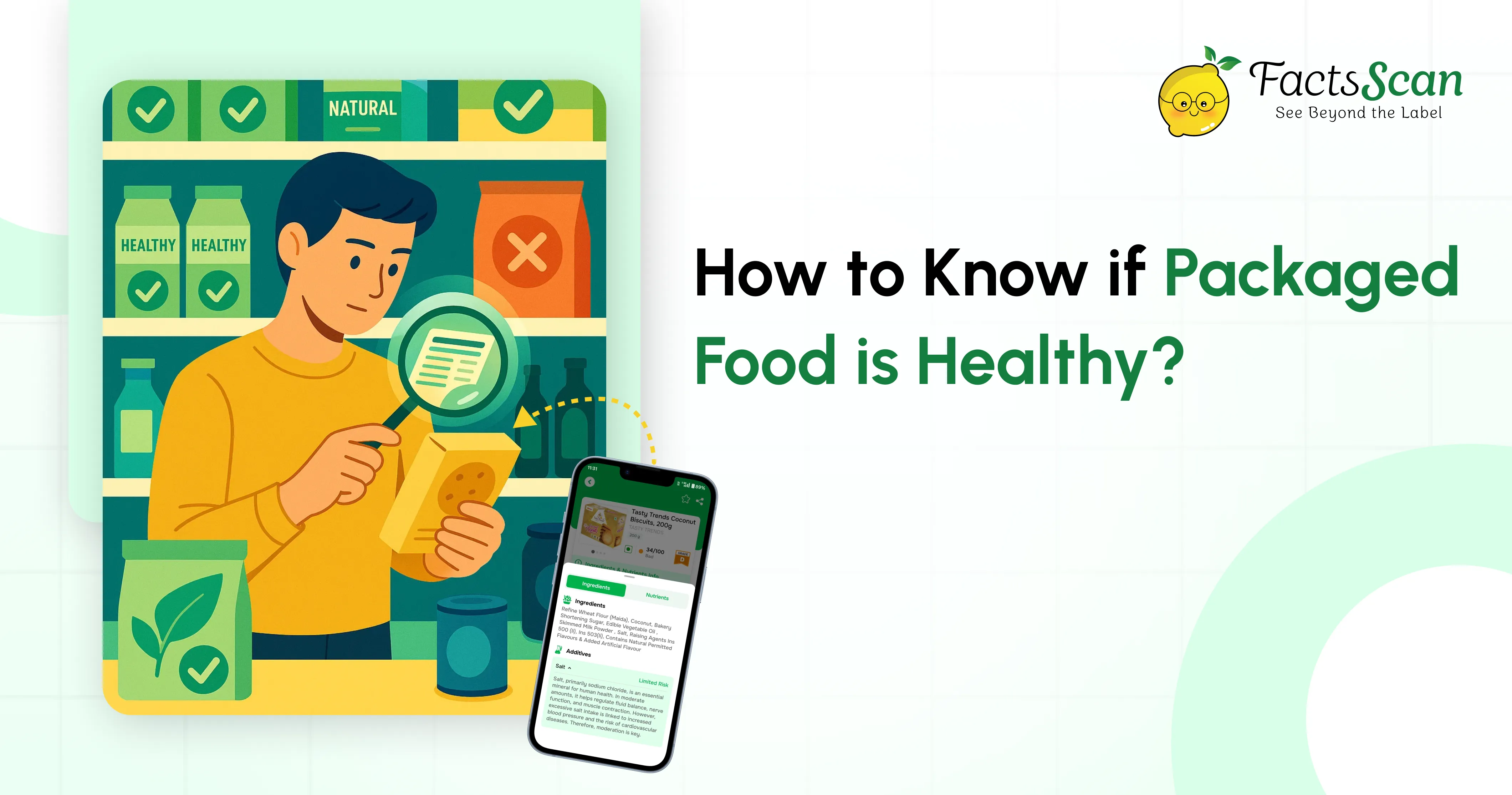How to Know if Packaged Food is Healthy?
Summary :
With rising consumption of packaged foods and misleading marketing claims, understanding what makes processed food truly healthy has become essential. This guide covers practical strategies for reading nutrition labels, identifying harmful additives, avoiding marketing tricks, and using modern tools to make informed food choices for better health outcomes.
Introduction
The convenience of packaged foods has revolutionized our eating habits. Research shows that ultra-processed foods now account for 25-60% of daily energy intake throughout much of the world. While convenient, this shift comes with significant health implications. Studies reveal that ultra-processed food exposure is directly associated with 32 health parameters spanning mortality, cancer, and mental, respiratory, cardiovascular, gastrointestinal, and metabolic health outcomes.
Many packaged foods carry attractive labels like “sugar-free,” “low-fat,” or “natural,” but these claims don’t always tell the complete story. A 2020 study found that front-of-package nutrition labels can create a “halo effect,” leading consumers to perceive even unhealthy products as healthier. Understanding how to know if packaged food is healthy requires looking beyond marketing claims to examine the actual nutritional content and ingredient quality.
The stakes are high. Convincing evidence shows that greater ultra-processed food exposure increases risks of cardiovascular disease-related mortality by 50%, type 2 diabetes, anxiety, and common mental disorders. Learning to evaluate packaged food healthiness isn’t just about nutrition, it’s about protecting your long-term health.
Check the Nutrition Label
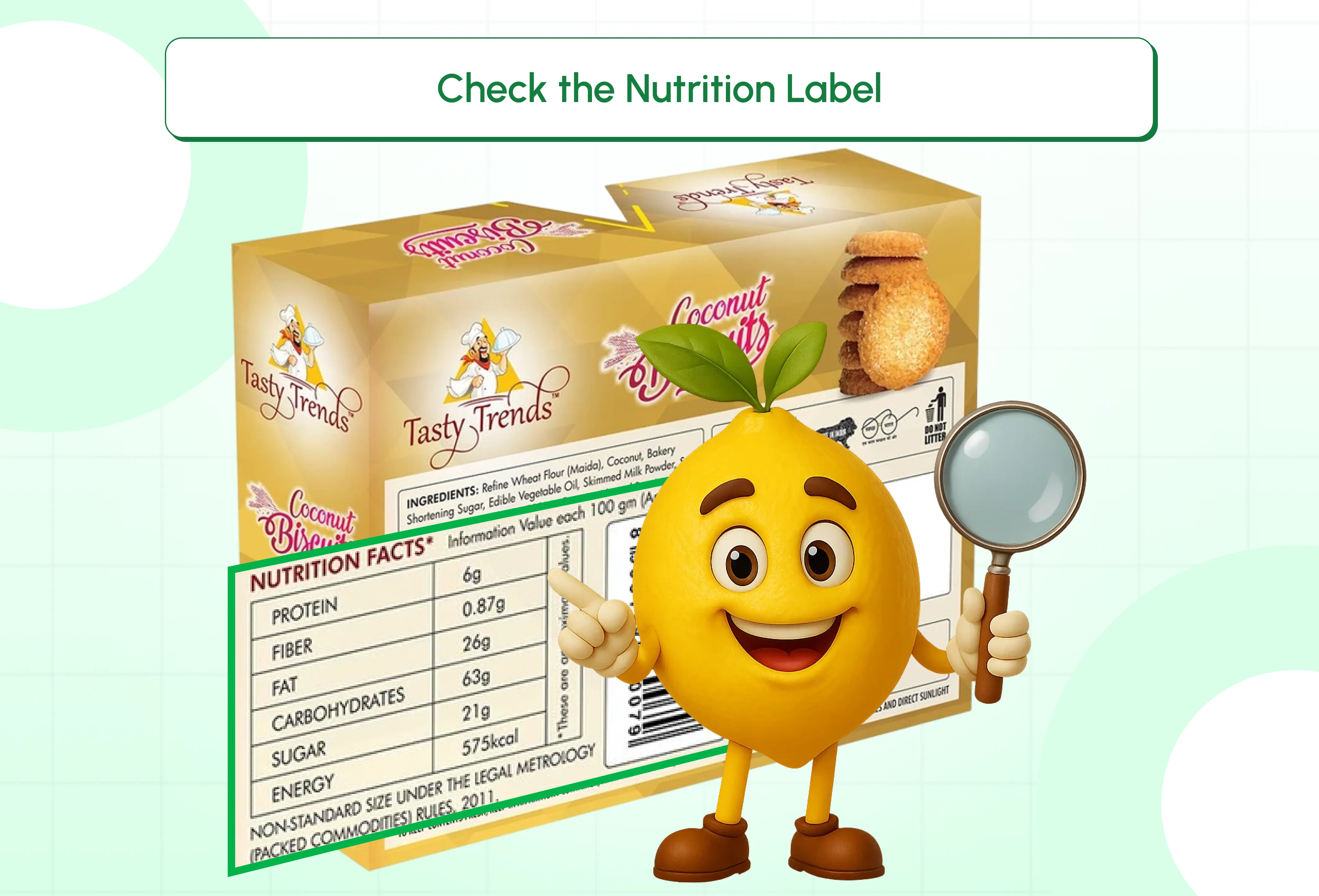
The nutrition label is your roadmap to understanding what’s really inside packaged food. Start with serving information, which appears at the top of every nutrition facts panel. This tells you both the serving size and total servings per container critical information since all other nutrient amounts are based on one serving.
1. Understanding Serving Size Tricks
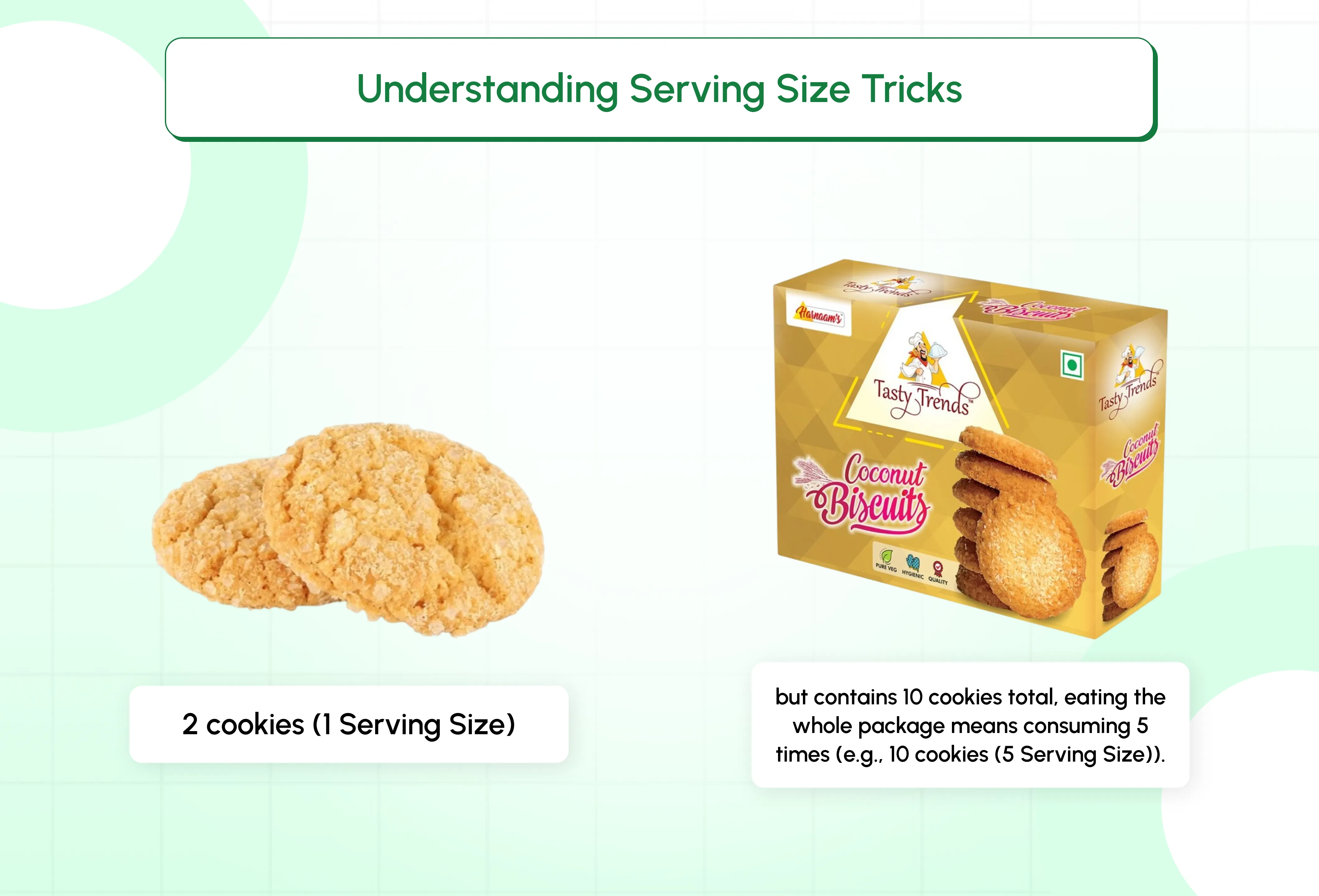
Food manufacturers sometimes use smaller serving sizes to make products appear healthier. If a cookie package lists 2 cookies as one serving but contains 10 cookies total, eating the whole package means consuming 5 times the calories, sugar, and fat shown on the label. Always check whether your actual portion matches the listed serving size.
2. Key Numbers to Focus On
When checking packaged food healthiness, pay attention to these crucial nutrients per serving:
- Calories: Compare to your daily needs and activity level.
- Saturated Fat:Limit foods with more than 5g per serving.
- Trans Fat: Avoid completely—even 0g listings can contain small amounts if “partially hydrogenated oil” appears in ingredients.
- Sodium: Choose foods with less than 600mg per serving; high sodium increases blood pressure risk.
- Added Sugars: The American Heart Association recommends no more than 25g daily for women and 36g for men.
3. Reading Sugar Content Properly
Added sugars are particularly tricky in packaged foods. Research analyzing 40,829 packaged food products found that 66% contained at least one added sugar in their ingredients. Look for the “Added Sugars” line, which was added to nutrition labels in recent years. This number doesn’t include natural sugars found in milk or fruit, only those added during processing.
Look at the Ingredient List
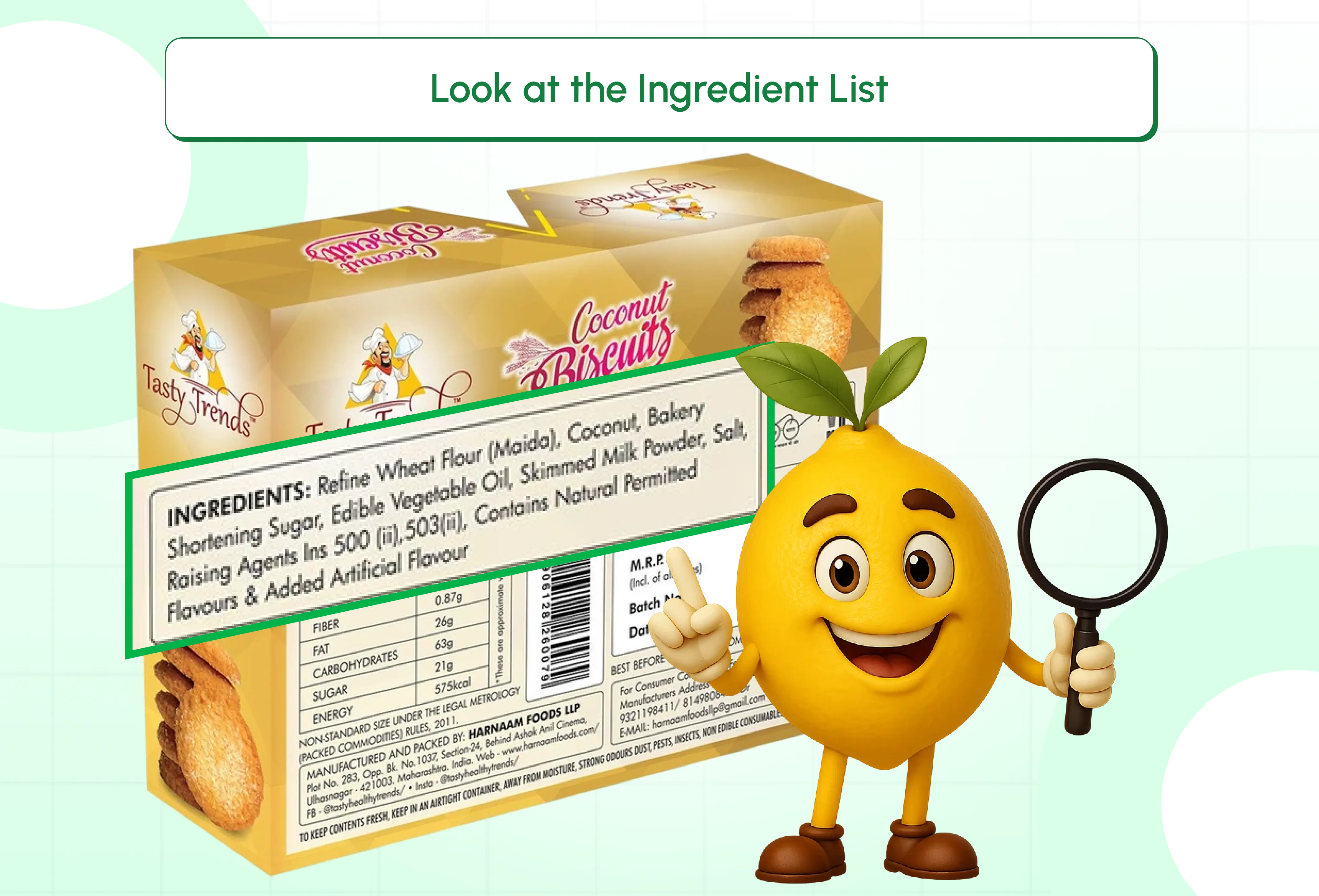
The ingredient list reveals the true quality of packaged food and helps determine if packaged food is healthy. Ingredients are listed by weight from highest to lowest, so the first three ingredients make up most of the product.
1. Red Flag Ingredients to Avoid
Several harmful additives commonly appear in processed foods:
- High Fructose Corn Syrup: Found in everything from bread to frozen pizza, this sweetener is linked to obesity and type 2 diabetes.
- Trans Fats/Partially Hydrogenated Oils: Associated with increased heart disease, stroke, and diabetes risk.
- Monosodium Glutamate (MSG): Can cause headaches, facial pressure, and chest pain in sensitive individuals.
- Artificial Food Coloring: Yellow #5, Blue #1, Red Dye #3, and Yellow #6 are linked to hyperactivity and behavioral issues.
- Sodium Nitrite: Found in processed meats, linked to increased pancreatic cancer risk.
- BHA and BHT: Preservatives that may affect the neurological system and potentially cause cancer.
2. Positive Signs to Look For
Healthy packaged foods typically contain:
- Whole Grains: Listed as “whole wheat flour” or “brown rice” rather than refined versions.
- Natural Proteins: Real meat, fish, beans, or nuts rather than protein isolates.
- Recognizable Ingredients: Items you’d find in your kitchen.
- Minimal Additives: Shorter ingredient lists generally indicate less processing.
- Natural Preservatives: Vitamin E or citric acid instead of chemical preservatives.
Watch Out for Marketing Gimmicks
Understanding marketing tactics is crucial for determining how to know if packaged food is healthy. Food companies invest heavily in packaging claims that may mislead consumers about nutritional value.
1. “Low Fat” Doesn’t Mean Healthy
When fat is removed from products, manufacturers often add sugar to maintain taste. Many low-fat products contain significantly more sugar than their full-fat counterparts. For example, some low-fat yogurts contain up to 20g of added sugar per serving—nearly an entire day’s recommended limit.
2. The “Organic” Misconception
While organic certification requires avoiding synthetic pesticides and GMOs, it doesn’t guarantee healthiness. Organic cookies, chips, and sodas are still highly processed foods high in sugar, salt, and calories. One food policy expert noted: “The organic label is no more than a marketing tool. It is not a statement about food safety. Nor is ‘organic’ a value judgment about nutrition or quality”.
3. “Natural Flavors” vs Real Natural Ingredients
Natural flavors sound healthy but are often as processed as artificial ones. The FDA defines natural flavors as compounds extracted from plants, animals, or fermentation products—but the extraction process can be highly chemical-intensive. A natural grape flavor might come from a non-grape herb, while an artificial flavor could be chemically identical to compounds found in real grapes.
Healthy vs Unhealthy Packaged Food Examples
Comparing similar products reveals dramatic differences in nutritional quality and helps you understand how to check packaged food healthiness.
1. Breakfast Cereals: A Tale of Two Choices
Unhealthy Example: Many colorful children’s cereals contain 12-15g of sugar per serving (equivalent to 3-4 teaspoons), artificial colors, and refined flour as the first ingredient.
Healthy Example: Plain oatmeal or cereals listing whole grains first, containing 6g or less sugar per serving, and providing at least 3g of fiber.
2. Juice Products: Marketing vs Reality
Unhealthy Example: Fruit drinks often contain only 10% real juice, with high fructose corn syrup and artificial flavors making up the rest. A 16oz serving can contain 72g of sugar—equivalent to 18 teaspoons.
Healthy Example: 100% fruit juice with no added sugars, consumed in moderation (4-6oz servings), or better yet, whole fruits that provide fiber along with natural sugars.
3. Snack Comparisons
Unhealthy Options: Potato chips fried in trans fats, cookies with refined flour and high sugar content, candy bars with artificial ingredients.
Healthier Alternatives: Air-popped popcorn, nuts and seeds, homemade trail mix with dried fruit, Greek yogurt with minimal added sugar.
Role of Food Additives and Preservatives
Understanding food additives helps determine if packaged food is healthy. While some additives serve legitimate functions like preventing spoilage, others pose health risks.
1. Harmful Additives to Limit
Aspartame: This artificial sweetener, 200 times sweeter than sugar, is found in diet sodas and sugar-free products. Studies show it can increase blood glucose levels and may cause anxiety.
Carrageenan: Derived from red seaweed and used as a thickener in dairy alternatives, carrageenan may trigger inflammation and digestive issues. Animal studies linked it to increased blood sugar and glucose intolerance.
Sodium Benzoate: Common in carbonated drinks and acidic foods, this preservative can form benzene (a potential carcinogen) when combined with vitamin C. Studies also link it to increased hyperactivity in children.
2. Safer Alternatives to Look For
Natural preservation methods include:
- Vitamin E (Mixed Tocopherols): Natural antioxidant that prevents rancidity.
- Citric Acid: Naturally occurring preservative from citrus fruits.
- Salt and Vinegar: Traditional preservation methods.
- Rosemary Extract: Natural antioxidant preservative.
How Apps Help You Identify Healthy Packaged Foods
Modern technology makes it easier than ever to determine how to know if packaged food is healthy. Food scanning apps provide instant analysis of nutrition labels and ingredient lists.
1. The Power of Barcode Scanning
Food scanner apps work by reading product barcodes and accessing comprehensive databases of nutritional information. Simply point your phone’s camera at a barcode to receive instant insights about calories, additives, allergens, and overall health ratings.
2. FactsScan App Features
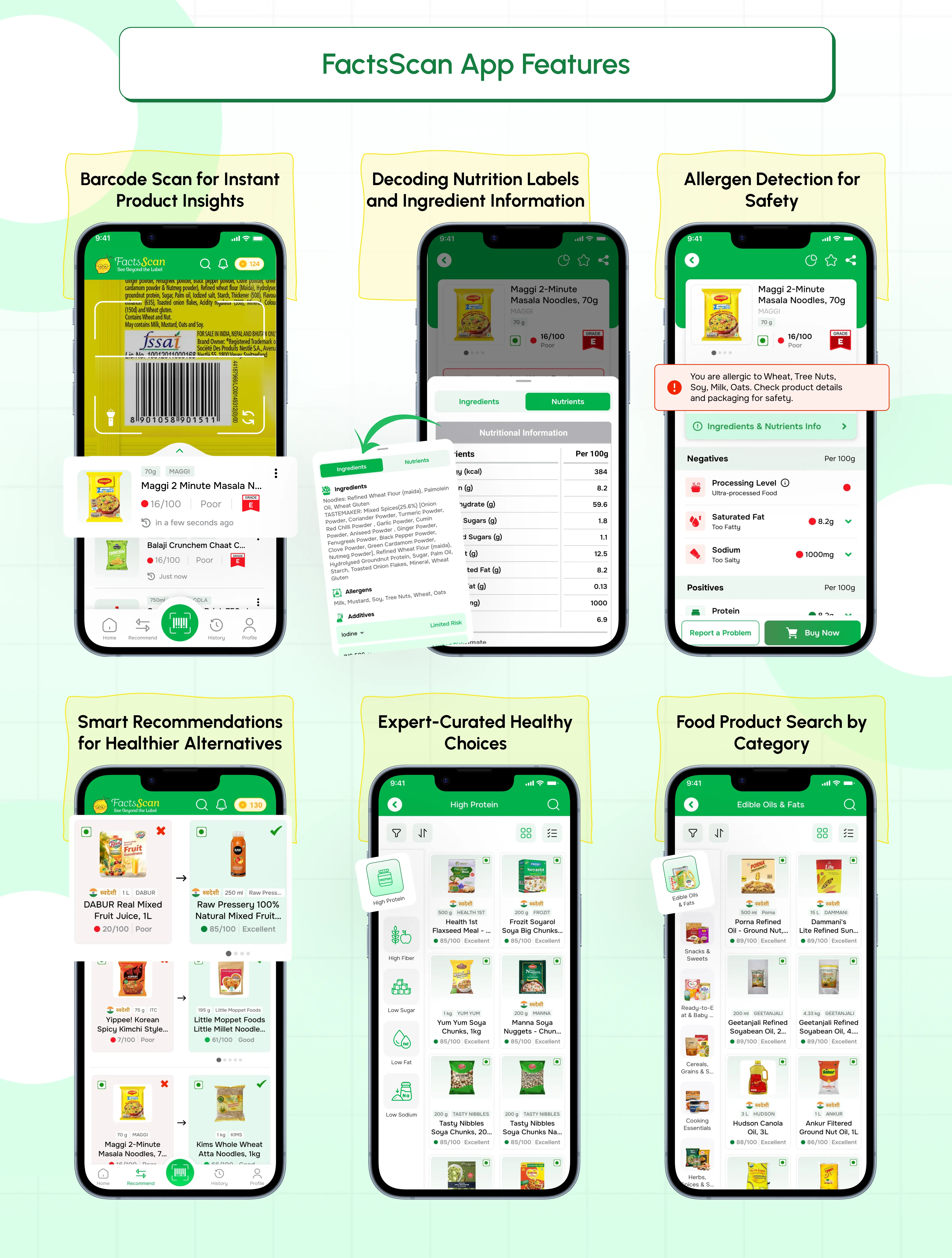
FactsScan stands out as a comprehensive food analysis tool designed specifically for health-conscious consumers:
- Barcode Scan for Instant Product Insights: Scan any packaged food product to unlock detailed nutrition facts, ingredient analysis, and health scoring. The app analyzes every component and assigns a health score from Grade A (healthy) to Grade E (unhealthy).
- Decode Nutrition Labels and Ingredient Information: Complex nutrition labels become simple visual breakdowns. The app highlights key nutrients like calories, fats, sugars, proteins, and fiber while flagging harmful ingredients such as trans fats, artificial preservatives, and excessive additives.
- Allergen Detection for Safety: Automatic identification of common allergens including gluten, dairy, nuts, and soy helps people with dietary restrictions make safe choices.
- Smart Recommendations for Healthier Alternatives: When you scan an unhealthy product, the app suggests better alternatives available in your area, making it easy to swap to healthier options.
- Expert-Curated Healthy Choices: The app features products recommended by nutrition experts, highlighting high-protein, high-fiber options for optimal health.
- Food Product Search by Category: Browse healthy options by category snacks, beverages, breakfast items to discover new products that meet your health criteria.
Real-Life Scenarios
Understanding how to apply these principles in everyday situations helps make checking packaged food healthiness a natural habit.
1. Parents Checking Snacks for Children
When shopping for kids’ snacks, focus on products with:
- Less than 10g sugar per serving
- At least 3g fiber or protein
- No more than 160mg sodium per serving
- Whole food ingredients like fruits, vegetables, or nut
Avoid brightly colored snacks with artificial dyes, as studies link food coloring to increased hyperactivity in children.
2. Diabetics Monitoring Sugar Intake
People managing diabetes must be especially vigilant about hidden sugars. Surprising high-sugar foods include:
- Barbecue sauce: 7g sugar per 2 tablespoons
- Flavored yogurt: up to 20g added sugar per serving
- Granola bars: 5-15g sugar per bar
- Ketchup: 4g sugar per tablespoon
Look for products labeled “no sugar added” and check that total carbohydrates align with your meal planning needs.
3. Fitness Enthusiasts Comparing Protein Bars
When evaluating protein bars for healthiness:
- Choose bars with at least 10g protein per serving
- Limit those with more than 10g added sugar
- Look for whole food ingredients like nuts, seeds, and dried fruit
- Avoid bars with long lists of unrecognizable chemicals
Conclusion
Learning how to know if packaged food is healthy requires developing skills in reading nutrition labels, understanding ingredient lists, and recognizing marketing tricks. The key is focusing on facts rather than front-package claims, prioritizing whole food ingredients over processed additives, and using available tools to make informed decisions.
Remember that healthy packaged food typically contains recognizable ingredients, minimal added sugars, adequate fiber or protein, and limited harmful additives. When in doubt, choose products with shorter ingredient lists and familiar components.
The rise of ultra-processed foods presents real health risks, but armed with knowledge and modern tools, you can navigate the grocery store confidently. Every scan, every label read, and every informed choice contributes to better health outcomes for you and your family.
Ready to take control of your food choices? Download the FactsScan app today to instantly check if packaged food is healthy. With just a simple barcode scan, you’ll unlock the nutritional truth behind every product, discover healthier alternatives, and make confident decisions that support your health goals. Start your journey toward healthier eating one scan at a time.
Ready to make Healthier Choices?
Download FactsScan now from the Google Play Store and App Store and take charge of your food choices.
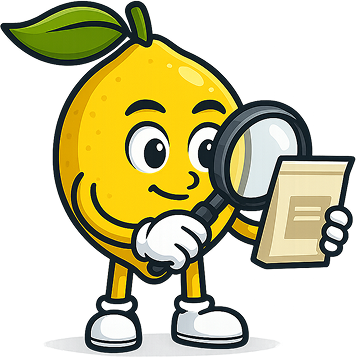
Recent Articles
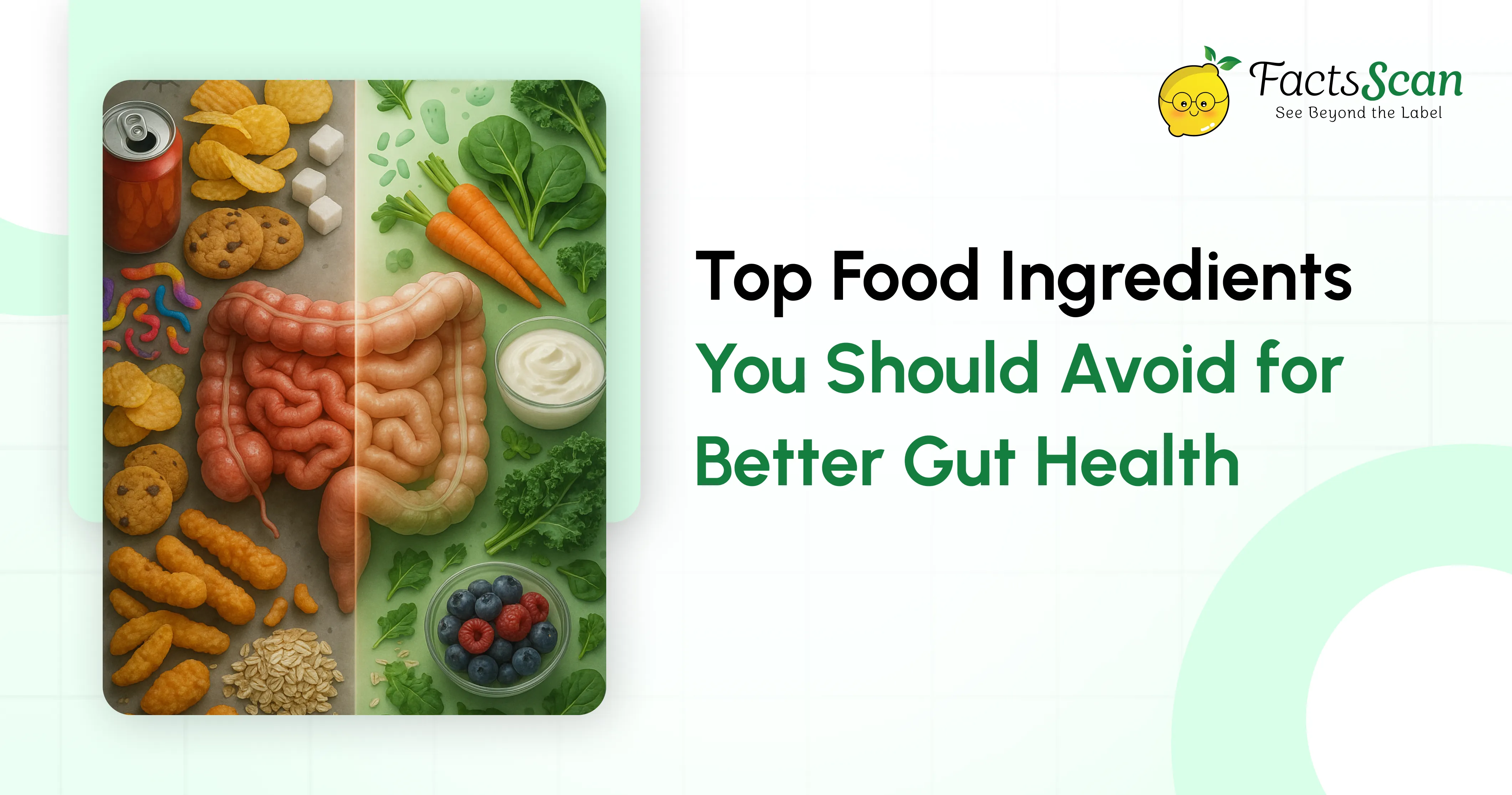
Top Food Ingredients You Should Avoid for Better Gut Health
Your gut microbiome is the foundation of your overall wellness, affecting everything from digestion to immune function. Yet many everyday food ingredients—artificial sweeteners, refined oils, emulsifiers, and preservatives—are slowly damaging this delicate ecosystem. Learn which harmful ingredients to eliminate from your diet and discover healthier alternatives using smart tools to identify nutritious, gut-friendly options that truly support your digestive health and long-term wellbeing.
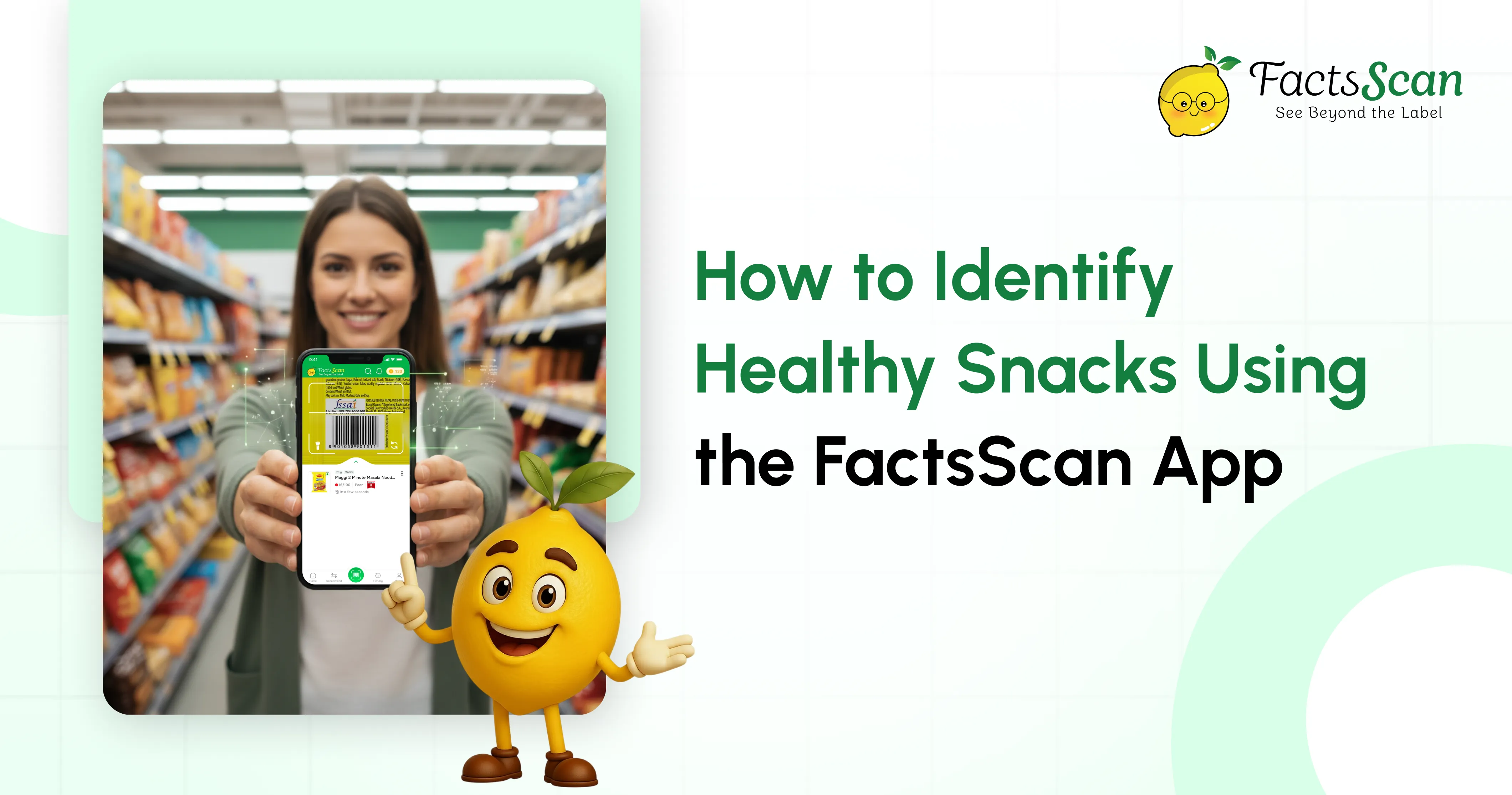
How to Identify Healthy Snacks Using the FactsScan App
Discover how the FactsScan App helps you make smarter snacking choices by instantly analyzing ingredients, nutrition scores, and additives. Learn how this AI-powered tool identifies truly healthy snacks and guides you toward better food decisions with just one scan.
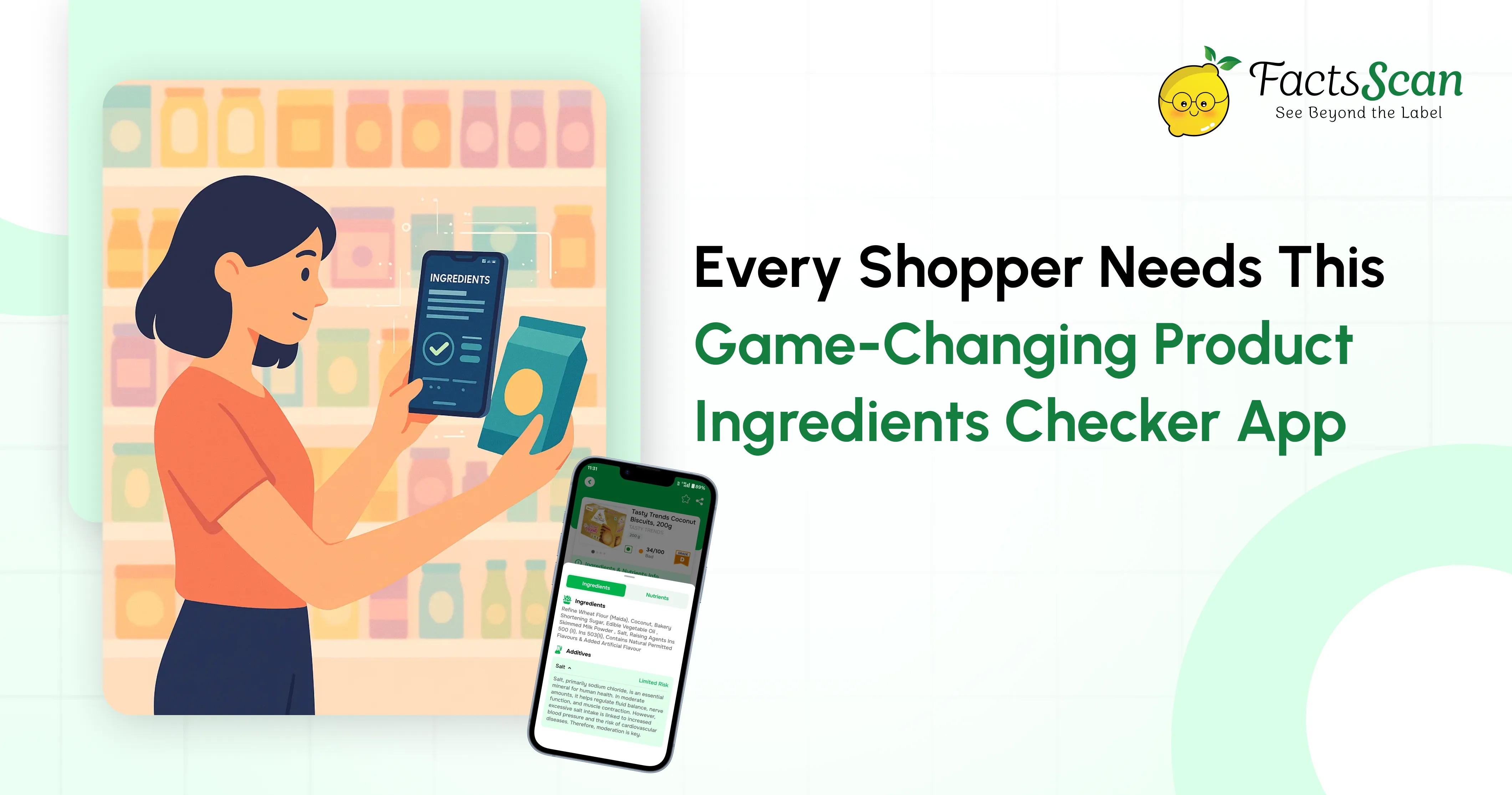
Every Shopper Needs This Game-Changing Product Ingredients Checker App
Tired of confusing food labels and hidden ingredients? This game changing product ingredients checker app helps shoppers instantly scan barcodes to uncover real nutritional facts, health scores, and safer alternatives, making smarter, healthier shopping easier than ever.
 03 Oct 2025
03 Oct 2025 10 Min Read
10 Min Read 
